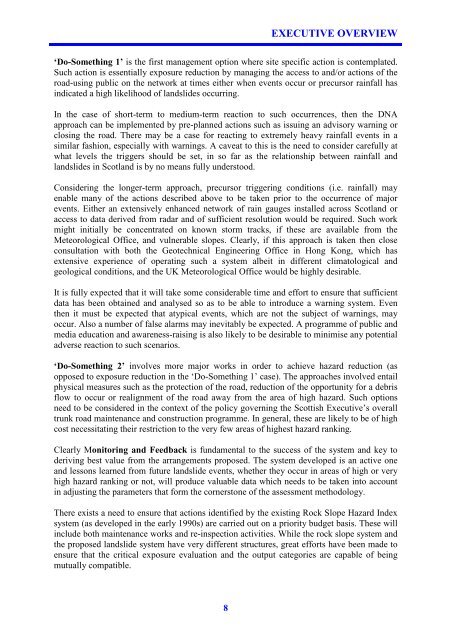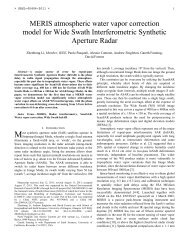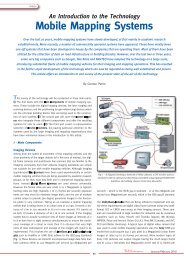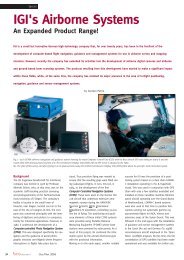Scottish Road Network Landslides Study - University of Glasgow
Scottish Road Network Landslides Study - University of Glasgow
Scottish Road Network Landslides Study - University of Glasgow
Create successful ePaper yourself
Turn your PDF publications into a flip-book with our unique Google optimized e-Paper software.
8<br />
EXECUTIVE OVERVIEW<br />
‘Do-Something 1’ is the first management option where site specific action is contemplated.<br />
Such action is essentially exposure reduction by managing the access to and/or actions <strong>of</strong> the<br />
road-using public on the network at times either when events occur or precursor rainfall has<br />
indicated a high likelihood <strong>of</strong> landslides occurring.<br />
In the case <strong>of</strong> short-term to medium-term reaction to such occurrences, then the DNA<br />
approach can be implemented by pre-planned actions such as issuing an advisory warning or<br />
closing the road. There may be a case for reacting to extremely heavy rainfall events in a<br />
similar fashion, especially with warnings. A caveat to this is the need to consider carefully at<br />
what levels the triggers should be set, in so far as the relationship between rainfall and<br />
landslides in Scotland is by no means fully understood.<br />
Considering the longer-term approach, precursor triggering conditions (i.e. rainfall) may<br />
enable many <strong>of</strong> the actions described above to be taken prior to the occurrence <strong>of</strong> major<br />
events. Either an extensively enhanced network <strong>of</strong> rain gauges installed across Scotland or<br />
access to data derived from radar and <strong>of</strong> sufficient resolution would be required. Such work<br />
might initially be concentrated on known storm tracks, if these are available from the<br />
Meteorological Office, and vulnerable slopes. Clearly, if this approach is taken then close<br />
consultation with both the Geotechnical Engineering Office in Hong Kong, which has<br />
extensive experience <strong>of</strong> operating such a system albeit in different climatological and<br />
geological conditions, and the UK Meteorological Office would be highly desirable.<br />
It is fully expected that it will take some considerable time and effort to ensure that sufficient<br />
data has been obtained and analysed so as to be able to introduce a warning system. Even<br />
then it must be expected that atypical events, which are not the subject <strong>of</strong> warnings, may<br />
occur. Also a number <strong>of</strong> false alarms may inevitably be expected. A programme <strong>of</strong> public and<br />
media education and awareness-raising is also likely to be desirable to minimise any potential<br />
adverse reaction to such scenarios.<br />
‘Do-Something 2’ involves more major works in order to achieve hazard reduction (as<br />
opposed to exposure reduction in the ‘Do-Something 1’ case). The approaches involved entail<br />
physical measures such as the protection <strong>of</strong> the road, reduction <strong>of</strong> the opportunity for a debris<br />
flow to occur or realignment <strong>of</strong> the road away from the area <strong>of</strong> high hazard. Such options<br />
need to be considered in the context <strong>of</strong> the policy governing the <strong>Scottish</strong> Executive’s overall<br />
trunk road maintenance and construction programme. In general, these are likely to be <strong>of</strong> high<br />
cost necessitating their restriction to the very few areas <strong>of</strong> highest hazard ranking.<br />
Clearly Monitoring and Feedback is fundamental to the success <strong>of</strong> the system and key to<br />
deriving best value from the arrangements proposed. The system developed is an active one<br />
and lessons learned from future landslide events, whether they occur in areas <strong>of</strong> high or very<br />
high hazard ranking or not, will produce valuable data which needs to be taken into account<br />
in adjusting the parameters that form the cornerstone <strong>of</strong> the assessment methodology.<br />
There exists a need to ensure that actions identified by the existing Rock Slope Hazard Index<br />
system (as developed in the early 1990s) are carried out on a priority budget basis. These will<br />
include both maintenance works and re-inspection activities. While the rock slope system and<br />
the proposed landslide system have very different structures, great efforts have been made to<br />
ensure that the critical exposure evaluation and the output categories are capable <strong>of</strong> being<br />
mutually compatible.

















